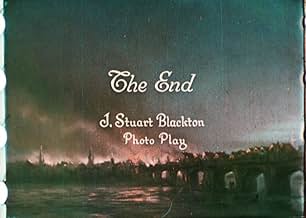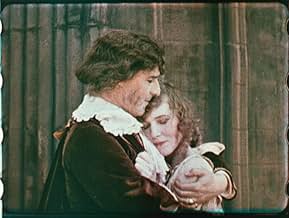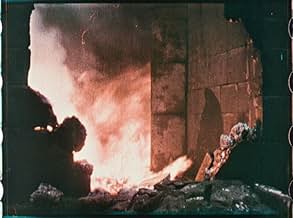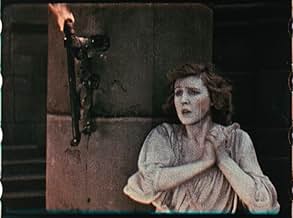Füge eine Handlung in deiner Sprache hinzuAn Earl's cousin survives drowning and saves a lady from the Great Fire of London.An Earl's cousin survives drowning and saves a lady from the Great Fire of London.An Earl's cousin survives drowning and saves a lady from the Great Fire of London.
- Regie
- Drehbuch
- Hauptbesetzung
Tom Heslewood
- Solomon Eagle
- (as Tom Heselwood)
Empfohlene Bewertungen
Considered a major event in its day and deemed of sufficient historical interest to qualify for an entry in the 'The Filmgoers Companion'. Although sarcastically described by Philip Ziegler as "a foolish fandango based vaguely on Carolean politics and the Great Fire of London", while Rachel Low predictably dismissed it as "monumentally slow and dull". Despite Ziegler lamenting in 1981 that at that time only twenty minutes of the film survived and that the quality of the print then available was "so poor that it is hard to be certain what it was really like", 'The Glorious Adventure' by one of those happy chances of film history miraculously survives and can now be viewed on YouTube.
As a film in its own right it frankly resembles the nonsense Herbert Wilcox would soon be making with Anna Neagle. Lady Diana Manners like many society beauties of yesteryear makes little impression in the lead, but compensations can be found in the supporting cast, including Victor McLaglan bearing his teeth and rolling his eyes as 'notorious rogue' Bulfinch, Lennox Pawle (best remembered as Mr Dick in MGM's 1935 version of 'David Copperfield') as a cherubic Samuel Pepys, and the Hon. Lois Sturt as a saucy young Nell Gwynn.
The Prizma Colour process itself (a direct lineal descendant of Cinecolor) does a satisfactory job of rendering both moonlight and the Great Fire of London (staged in a warehouse off the Strand) in the obligatory conflagration that was already the standard conclusion of early colour productions.
As a film in its own right it frankly resembles the nonsense Herbert Wilcox would soon be making with Anna Neagle. Lady Diana Manners like many society beauties of yesteryear makes little impression in the lead, but compensations can be found in the supporting cast, including Victor McLaglan bearing his teeth and rolling his eyes as 'notorious rogue' Bulfinch, Lennox Pawle (best remembered as Mr Dick in MGM's 1935 version of 'David Copperfield') as a cherubic Samuel Pepys, and the Hon. Lois Sturt as a saucy young Nell Gwynn.
The Prizma Colour process itself (a direct lineal descendant of Cinecolor) does a satisfactory job of rendering both moonlight and the Great Fire of London (staged in a warehouse off the Strand) in the obligatory conflagration that was already the standard conclusion of early colour productions.
I watched a simply fantastic film last night, "The Glorious Adventure" (1922), a British adventure/history/period piece starring Lady Diana Manners, Cecil Humphreys, Gerald Lawrence, and in his sixth film, young Victor McLaglen, along with many, many more in this J. Stuart Blackton produced-by/directed-by film. The first striking thing is that this was Britain's first all-color feature film, made in a process called Prizma Colour. "The Toll of the Sea", also 1922, is the first surviving feature of the two-strip Technicolor process, and it looks quite good in comparison, frankly, but "The Glorious Adventure", as washed out as it appears in a few places, nevertheless is still stunningly beautiful in many ways, and the costuming alone allows for the full use of fine color photography.
This one is a well-acted piece, too, not prone to the arm-slinging, hand-to-mouth wide gesturing of so many pictures in the 1914-1925 stretch of time. Rather, it captures the feel of thirties American and British adventure films with the likes of Errol Flynn or John Clements. Gerald Lawrence plays the inheritor of a barony who has it stolen out from under him by an underhanded Cecil Humphreys who has Lawrence thrown into the sea and supposedly drowned by Victor McLaglen. Of course, Lawrence doesn't drown, as we find out later. Meanwhile, the lady of the piece, Lady Beatrice Fair, played by Lady Diana Manners, is put through life trial after life trial during this period of Charles II and his Restoration, including by the king himself, played by William Luff. Eventually, all this, taking place in, near, and around London, leads to the great fire of London in 1666. The fire and the events played out during the fire is not only first rate movie making, but for 1922 is spectacular in the first degree! I was not only impressed, but, frankly, surprised how great the scenes were! The film was released 1 January 1922, so it was obviously made during 1921.
I enjoy period pieces very much, especially if they're well done. This one not only incorporates a good amount of genuine history and historical characters in its telling of a fictional story, but does it with aplomb. Just watching Lennox Pawle as Samuel Pepys is a hoot! Kudos to the actors and actresses, the director, the photographer, the editor, but also to the scenario writer, Alma Reville (Mrs. Alfred Hitchcock later).
This one is a well-acted piece, too, not prone to the arm-slinging, hand-to-mouth wide gesturing of so many pictures in the 1914-1925 stretch of time. Rather, it captures the feel of thirties American and British adventure films with the likes of Errol Flynn or John Clements. Gerald Lawrence plays the inheritor of a barony who has it stolen out from under him by an underhanded Cecil Humphreys who has Lawrence thrown into the sea and supposedly drowned by Victor McLaglen. Of course, Lawrence doesn't drown, as we find out later. Meanwhile, the lady of the piece, Lady Beatrice Fair, played by Lady Diana Manners, is put through life trial after life trial during this period of Charles II and his Restoration, including by the king himself, played by William Luff. Eventually, all this, taking place in, near, and around London, leads to the great fire of London in 1666. The fire and the events played out during the fire is not only first rate movie making, but for 1922 is spectacular in the first degree! I was not only impressed, but, frankly, surprised how great the scenes were! The film was released 1 January 1922, so it was obviously made during 1921.
I enjoy period pieces very much, especially if they're well done. This one not only incorporates a good amount of genuine history and historical characters in its telling of a fictional story, but does it with aplomb. Just watching Lennox Pawle as Samuel Pepys is a hoot! Kudos to the actors and actresses, the director, the photographer, the editor, but also to the scenario writer, Alma Reville (Mrs. Alfred Hitchcock later).
Wusstest du schon
- WissenswertesDebut of actresses Norma Varden, Phyllis Clare and Marian Constance Blackton.
Top-Auswahl
Melde dich zum Bewerten an und greife auf die Watchlist für personalisierte Empfehlungen zu.
Details
- Erscheinungsdatum
- Herkunftsland
- Sprache
- Auch bekannt als
- La Glorieuse Aventure
- Drehorte
- Produktionsfirma
- Weitere beteiligte Unternehmen bei IMDbPro anzeigen
- Laufzeit1 Stunde 10 Minuten
- Sound-Mix
- Seitenverhältnis
- 1.33 : 1
Zu dieser Seite beitragen
Bearbeitung vorschlagen oder fehlenden Inhalt hinzufügen

Oberste Lücke
By what name was The Glorious Adventure (1922) officially released in Canada in English?
Antwort













